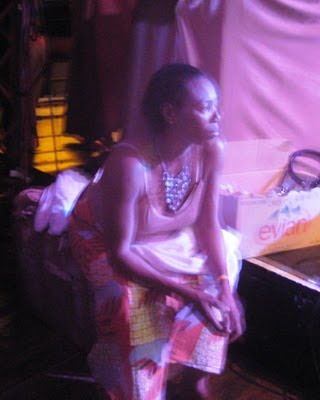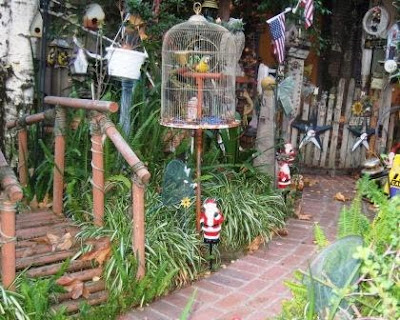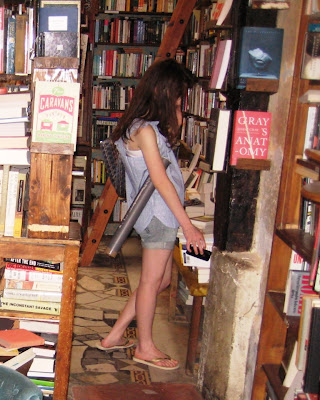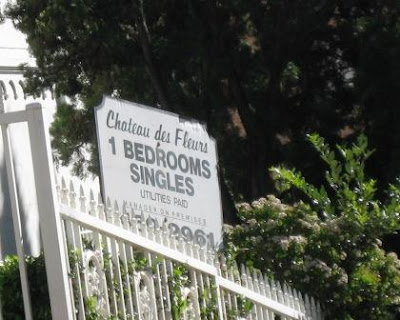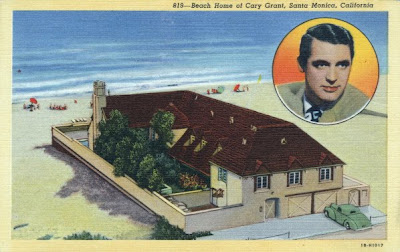
After we lost the services of Rita, our long-time housecleaner, I tried to go it on my own, but soon
[The Man I Love] found a better solution to our domestic maintenance. Oeuf and Eigh are a couple, and work together to clean houses. They came highly recommended. Their price is a bit higher than Rita's was, but they promise far better service.
They are middle-aged. Oeuf is a tiny woman with short black hair and a sweet smile. She wears sweatsuits and sneakers and fancy glasses. Eigh is a big bear-like man, who favors shorts, black socks and sandals, and T-shirts printed with metallic fleur-de-lis and other rock-goth designs. They come from a European country to go unnamed in these dispatches, and their English is just shy of fluent - sometimes we have communication difficulties that have to be sounded or mimed out.
When we first interviewed them, they were delighted to hear of
[The Man I Love]'s work in music. They had worked for a musician once, they said, at his home in Calabasas. "You know this...ah... this
Shoooog Nite?" asked Eigh.
The first day they worked, they were in our house for seven hours. Now, it's true our house had gone uncleaned for a couple of months. [The Man I Love] and I had managed to do some triage cleaning, but I am not embarrassed to say that I have become so spoiled over the years by even Rita's lack-luster work that it took me a couple weeks of her absence for it even to occur to me to pick up a broom. But seven hours!
One thing that might have lengthened that first day was that, a half hour into the day, Eigh discovered that the sliding glass shower enclosure door needed repair - it didn't slide properly and sometimes jammed. This, of course, is something that [The Man I Love] and I have been not-dealing-with for thirteen years, and something Rita cheerfully put up with as if it were a fact of life. From the bathroom, we heard the door scraping and thudding and rumbling, and [The Man I Love] dashed into the room to tell Eigh, "Oh, don't worry, that's always been that way, you don't have to -"
By that time, Eigh had the whole door off its track and was unbolting the broken and corroded rollers. He stammered apologies in broken English, and we worried that maybe our new house cleaner was going to well-meaningly break everything in our house. He asked if there was a hardware store nearby.
By the end of the day, the door rolled along its tracks smoother than it had ever rolled before.
"Just you wait," said Eigh. "In one year, maybe two years, I finally fix everything you need fixed."
Slowly, Ouef and Eigh have begun to take over our house. And it's sometimes alarming. The built-up
nasty finish on the hardwood floor? We told Eigh about it. When we came home after the second week's cleaning, the entire kitchen floor was clean. The third week, half the living room was clean. On the fourth week, I had to stay home from work and discovered to my shock and horror that Eigh was pouring un-diluted ammonia on the boards and scrubbing it with a machine. The fumes drove me from the house.
But the floor was clean. I checked their contractor records to make sure their insurance was paid up.
True to his promise, Eigh has repaired many things in the house, including a kitchen light fixture that stopped working; some loosened slate tile in our entryway; a blocked sink drain and a broken light switch.
They clean the oven each week, scour grease-blackened baking pans, and clean the refrigerator. Eigh even deep-scrubbed and oil-treated our wooden cutting board - with an admonishment to me not to use water on it ever again.
They even take Jack for a walk when they're here.
Oeuf and Eigh have a small dog who used to stay in a carrier when they worked, until we determined that Jack enjoyed the companionship. So each Monday when they arrive, Jack and the little dog chase each other around the house. Then the little dog has a snack from Jack's food dish.
Oeuf is the quiet one. If she needs to clean where you happen to be, she apologizes profusely, eyes blinking behind the fancy glasses. "I'm sorry!"
About three weeks into our relationship, Eigh started pressing the clothes left on the ironing board. Since these were mostly [The Man I Love]'s suits and slacks for work, and I am a reluctant ironer, he loved it. One week, Eigh asked for permission to take one of [The Man I Love]'s shirt home, so he could properly select the right replacement button from his collection. When he brought the shirt back, he presented it for our admiration. Indeed, the button perfectly matched.
[The Man I Love] is delighted with this kind of service, which is a testimony to how much pampering he's been denied living for 25 years with a housewife as lax as I am. I teased him that he now had his own manservant.
But to be honest, all this is making me a little nervous. Oeuf and Eigh are also doing our laundry, folding our clothes and reorganizing our dresser drawers. I'm not used to this level of intimacy from strangers.
It took a while to adjust to having other people deal with our clothing. We found that our familiar methods of dividing dirty from clean didn't translate immediately to other people. We learned this after Eigh, doing the shirts on the ironing board in the spare room, also ironed and hung up the dirty clothes piled on the floor, which were meant for the dry-cleaner. We didn't realize this until [The Man I Love] took a meticulously pressed pair of slacks off the hanger, only to realize it stank. Now we carefully segregate the dry-cleaning from the ironing into hampers.
They certainly do go above and beyond the call of duty. Back in the spring, when the local fire department did its annual inspection, we were not at home, but Oeuf and Eigh were cleaning that day. The firefighters noted we needed to clean the leaves off our flat roof.
The next week, Eigh was up on the roof, sweeping off the leaves. Once again, I hoped their insurance was paid up.
They both take great pride in their work, and want to share in their enthusiasm. They want us to know what a good job they've done. Each week when Eigh arrives, he asks how we enjoyed whatever project he completed last week, and points out the next target of his attention. He often arrives with a package, unveiling the next improvement for our lives. One morning it was a new iron - he said the old one leaked.
Last week, as I pulled out of the driveway, they were unloading the many appliances and cleaning products they bring for their workday from their car trunk. Eigh hailed me, and brandished two narrow fluorescent fixtures. "I put these in kitchen!" he said excitedly. "To fix the lighting!"
Now, this is something of a sore spot with me. When we remodeled the kitchen eight years ago, I wanted to install low-voltage lights underneath the upper cabinets, to light the counters and work surfaces. The contractor ran the wiring for it, but then presented me with his choice of light fixtures - really ugly fluorescent tube lights. I said - forget it. That wasn't what I had in mind. Just leave the wiring there and I'll regroup later on and install the kind I want.
Well, it's been eight years. I know exactly what I want - I want
under-cabinet LED lights. They're compact, the light source is hidden behind the cabinet face so it doesn't glare, and they are energy efficient. But they cost a lot and you have to plan carefully which components to get, and I just simply have not gotten around to doing it or finding a contractor to work with.
I've learned that you have to be careful what you mention to Eigh. If you say, "Oh, I haven't got around to fixing the ____" or "I wish I could find a ____ that would do____" he will take it on as a project. So the only thing I can think is that at some point [The Man I Love] or I mentioned that it was a shame the lighting in the kitchen was so bad but that we wished someday we could have under-cabinet lights - and Eigh acted on it.
So I looked in horror at the two fluorescent fixtures. But I was on my way to work. "I get from IKEA. I try them," said Eigh. "You will like!"
"Um..," I said, "Okay, let's see, but don't buy anymore until we can talk!"
[The Man I Love] called me at work to report his conversation with Eigh after I left. "She will like, you will see," Eigh had promised. "Kitchen will be so bright she will have to wear sunglasses!"
As a little aside here, I have to mention that as an anthropologist, [The Man I Love] really enjoys other people, and enjoys the often unique and fascinating way people of other countries have adapted to the culture of the U.S., and particularly Los Angeles. The fact that a couple from a former Soviet-bloc country could come to L.A. and allow their work ethic and entrepreneurial spirit to flourish and succeed is wonderful, and it's great to know them and learn from them. But sometimes [The Man I Love]'s interest in the characters leads to bad decisions. Like the time we hired a charming yet crooked contractor to remodel the basement, hiring undocumented Persian workers. I mistrusted the guy from the start, but he won over [The Man I Love] with his quirky sense of humor and his assurances of success. "You're gonna love it," he promised, even while he was swapping out our older fixtures for cheap junk, installing the wrong kind of hardware, and stealing building materials we paid for.
To this day, "You're gonna love it!" is what my family says when we sense a conman's pitch.
With Oeuf and Eigh, it's different. They're not dishonest, and they're not incompetent. It's just - I don't want Eigh to install ugly fluorescent tubes under my cabinets. When I came home that night, there were were, glaring out at me with the tubes flickering starkly. I hated them.
I had to figure out how to tell him to STOP. WAIT. But I wanted to be constructive. I didn't want to dampen his enthusiasm, or hurt his feelings. And I also feel a little bit at a disadvantage. I mean - this is a the guy who launders my underwear. I don't want to get on his bad side. I asked [The Man I Love] to call him and tell him to hold off buying any more lights, we would talk with him the following week.
So I spent the weekend doing what I had avoided for the last eight years. Measure the cabinets. Research the fixtures. Go to the lighting store and look at the products. Get brochures. Price them out. All that work and time spent, just to stop Eigh from forcing his will on my kitchen.
The relationships you have with the people who do domestic work for you are tricky. We pay them for their services, yet they know our secrets. We hire them, yet we allow them to dominate us. We fear offending them. In 1934,
Dorothy Parker wrote a short story called "Mrs. Hofstadter on Josephine Street." Although the story suffers from the casual racism of the period, it captures hilariously the sense of obligation and helplessness the two main characters - Parker and her husband - feel as their lives are held hostage to a garrulous and attention-craving servant who insinuates himself into their family and simply won't leave them alone.
"Can you have a glass of water!" Horace said. "Can you have a glass of water! Well, I'll tell you just what Horace is going to do. He's going out there in that kitchen, and he's going to bring you just the biggest, coolest glass of water you ever had in your life. There's going to be nothing too good for you, now Horace is here. Why, he's going to do for you just like you was Mrs. Hofstadter, out in her lovely home on Josephine Street; yes, he is."
He left, turning his head archly back over his shoulder to bestow his parting smile.
...
Horace returned with the water and spoke to us. Through his preparations for dinner he spoke to us. Through dinner, which was held at six o'clock, according to the custom obtaining in Mrs. Hofstadter on Josephine Street's lovely home, he spoke to us. We sat there. Once the Colonel asked Horace for something and so learned his lesson forever. Better go without a service than bring on rich and recommended assurances of the tender perfection of its fulfillment.
On the next cleaning day, Eigh came in the house and asked me with a sad face, "You don't like the lights?"
I chose my words carefully. I liked having better lights, I told him. But there is a kind of light I really want instead. So please, don't get more of this kind - let's wait until I can get the kind I want. I had a printout from the Internet to show him. I praised his enthusiasm and thanked him for giving us the motivation to get back on track with this project.
He seemed to take it well. I felt better. And it's true - we will get the project back on track. Finally. I really should feel grateful for that.
As I gathered up my things to get ready to go to work, I overheard
[The Man I Love] talking with Oeuf and Eigh in the living room. "It's cold today," he said. "You can turn on the furnace in the basement, but it doesn't really do that great a job of heating the house. I think we need to have someone in to look at it...."
Uh oh.






